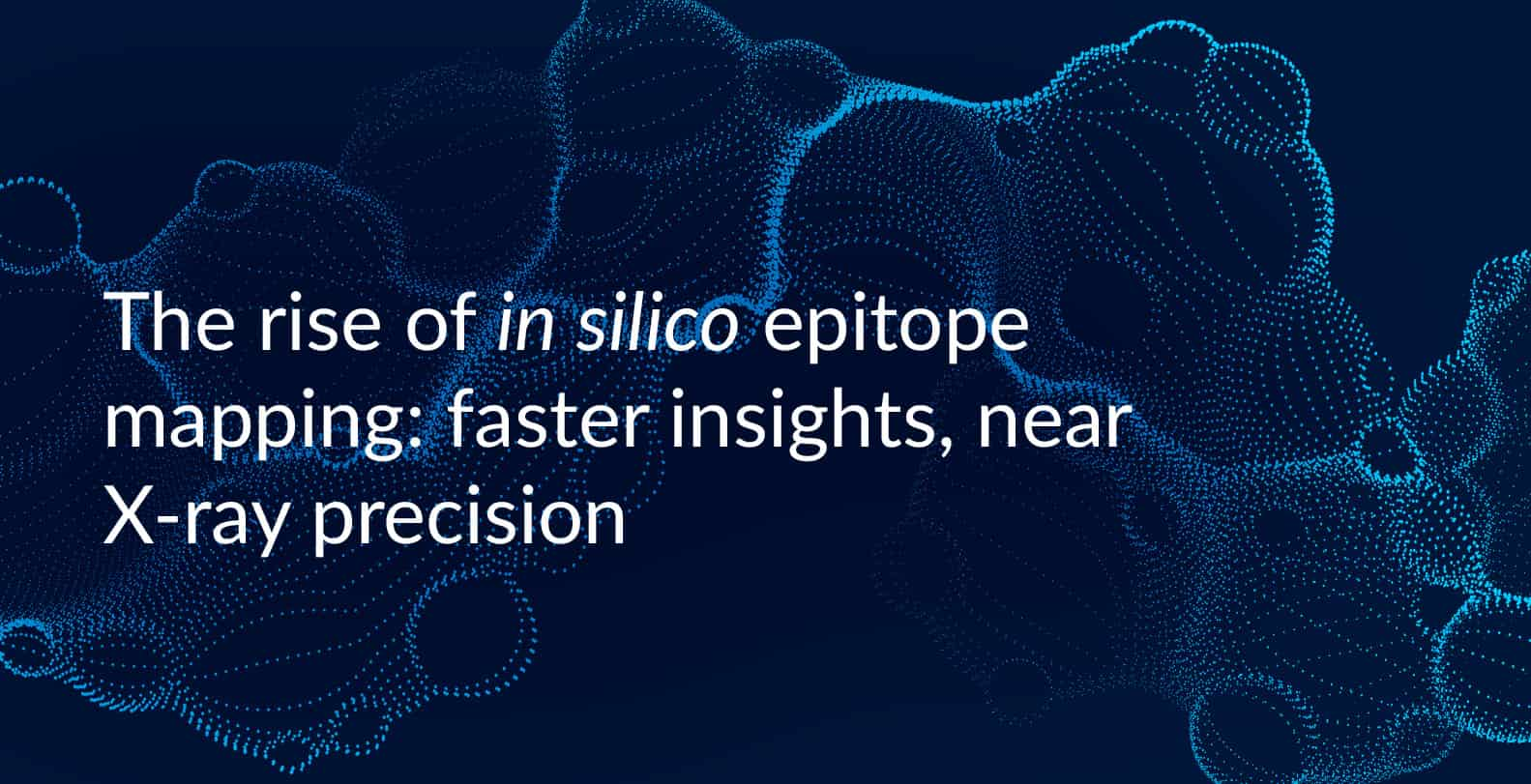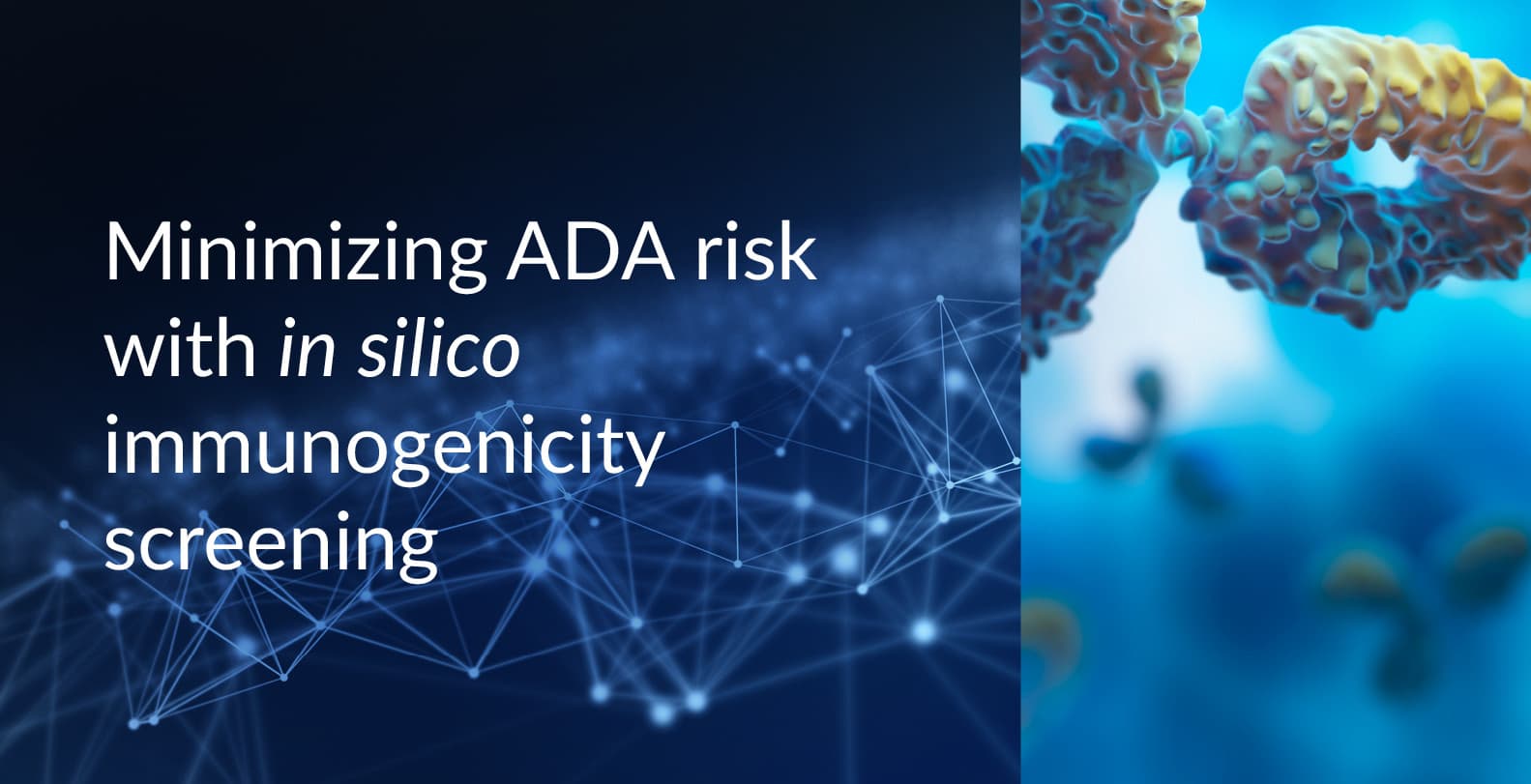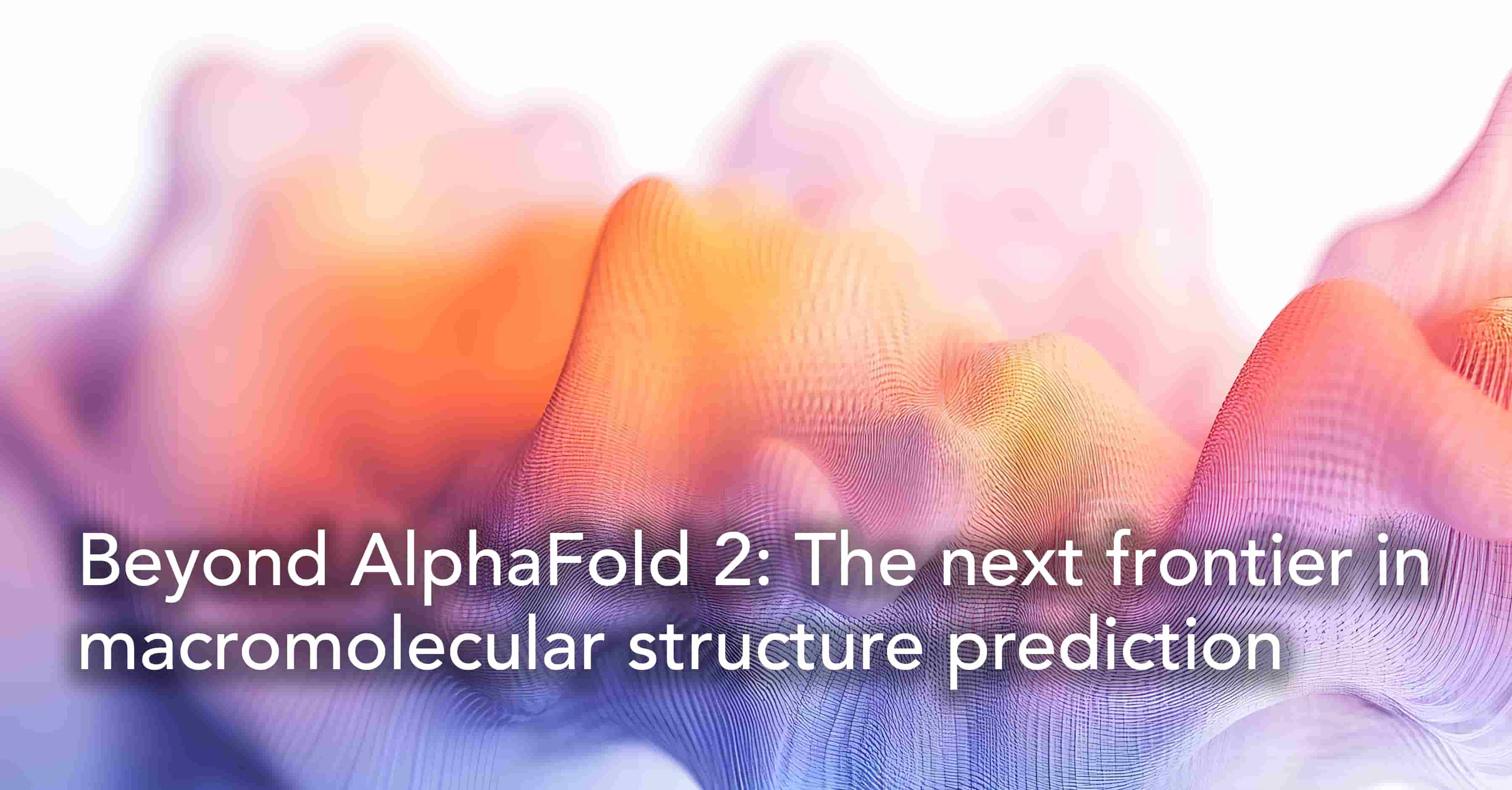The rise of in silico epitope mapping: faster insights, near X-ray precision

Audio version
Epitope mapping is a fundamental process to identify and characterize the binding sites of antibodies to their target antigens2. Understanding these interactions is pivotal in developing diagnostics, vaccines, and therapeutic antibodies3–5. Antibody-based therapeutics – which have taken the world by storm over the past decade – all rely on epitope mapping for their discovery, development, and protection. This includes drugs like Humira, which reigned as the world’s best-selling drug for six years straight6, and rituximab, the first monoclonal antibody therapy approved by the FDA for the treatment of cancer7.
Aside from its important role in basic research and drug discovery and development, epitope mapping is an important aspect of patent filings; it provides binding site data for therapeutic antibodies and vaccines that can help companies strengthen IP claims and compliance8. A key example is the Amgen vs. Sanofi case, which highlighted the importance of supporting broad claims like ‘antibodies binding epitope X’ with epitope residue identification at single amino acid resolution, along with sufficient examples of epitope binding8.
While traditional epitope mapping approaches have been instrumental in characterizing key antigen-antibody interactions, scientists frequently struggle with time-consuming, costly processes that are limited in scalability and throughput and can cause frustration in even the most seasoned researchers9.
The challenge of wet lab-based epitope mapping approaches
Traditional experimental approaches to epitope mapping include X-ray crystallography and hydrogen-deuterium exchange mass-spectrometry (HDX-MS). While these processes have been invaluable in characterizing important antibodies, their broader application is limited, particularly in high-throughput antibody discovery and development pipelines.
X-ray crystallography has long been considered the gold standard of epitope mapping due to its ability to provide atomic-level resolution10. However, this labor-intensive process requires a full lab of equipment, several scientists with specialized skill-sets, months of time, and vast amounts of material just to crystallize a single antibody-antigen complex. Structural biology researchers will understand the frustration when, after all this, the crystallization is unsuccessful (yet again), for no other reason than simply because not all antibody-antigen complexes form crystals11.
Additionally, even if the crystallization process is successful, this technique doesn’t always reliably capture dynamic interactions, limiting its applicability to certain epitopes12. The static snapshots provided by X-ray crystallography mean that it can’t resolve allosteric binding effects, transient interactions, or large/dynamic complexes, and other technical challenges mean that resolving membrane proteins, heterogeneous samples, and glycosylated antigens can also be a challenge.
HDX-MS, on the other hand, can be a powerful technique for screening epitope regions involved in binding, with one study demonstrating an accelerated workflow with a success rate of >80%13. Yet, it requires highly complex data analysis and specialized expertise and equipment, making it resource-intensive, time-consuming (lasting several weeks), and less accessible for routine use – often leading to further frustration among researchers.
As the demand for therapeutic antibodies, vaccines, and diagnostic tools grows, researchers urgently need efficient, reliable, and scalable approaches to accelerate the drug discovery process. In silico epitope mapping is a promising alternative approach that allows researchers to accurately predict antibody-antigen interactions by integrating multiple computational techniques14.
Advantages of in silico epitope mapping
In silico epitope mapping has several key advantages over traditional approaches, making it a beneficial tool for researchers, particularly at the early stage of antibody development.
- Speed – Computational epitope mapping methods can rapidly analyze antigen-antibody interactions, reducing prediction time from months to days11. This not only accelerates project timelines but also helps reduce the time and resources spent on unsuccessful experiments.
- Accuracy – By applying advanced algorithms, in silico methods are designed to provide precise and accurate predictions11. Continuous improvements in 3D modeling of protein complexes that can be used to support mapping also mean that predictions are becoming more and more accurate, enhancing reliability and success rates9.
- Versatility – In silico approaches are highly flexible and can be applied to a broad range of targets that may otherwise be challenging to characterize, ranging from soluble proteins, multimers, to transmembrane proteins. Certain in silico approaches can also overcome the limitations of X-ray crystallography as they can reliably study dynamic and transient interactions12.
- Cost-effectiveness – By reducing the need for expensive reagents, specialized equipment, and labor-intensive experiments, and by cutting timelines down significantly, computational epitope mapping approaches lower the cost of epitope mapping considerably11,15. This makes epitope mapping accessible to more researchers and organizations with limited resources.
- Scalability – In silico platforms can handle huge datasets and screen large numbers of candidates simultaneously, unlike traditional wet-lab methods that are limited by throughput constraints, enabling multi-target epitope mapping9. This is especially advantageous in high-throughput settings, such as immune profiling and drug discovery, and relieves researchers of the burden of processing large volumes of samples daily.
AI-powered in silico epitope mapping in action
Meet LENSai: Your cloud-based epitope mapping lab
Imagine a single platform hosting analytical solutions for end-to-end target discovery-leads analysis, including epitope mapping in hours. Now, this is all possible. Meet LENSᵃⁱ™ – an integrated intelligence platform hosting innovative analytical solutions for complete target-discovery-leads analysis and advanced data harmonization and integration.
LENSai Epitope Mapping is one of the platform’s applications that enables researchers to identify the amino acids on the target that are part of the epitope11. By simply inputting the amino acid sequences of antibodies and targets, the machine learning (ML) algorithm, combined with molecular modeling techniques, enables the tool to make a prediction. The outputs are:
- A sequence-based visualization containing a confidence score for each amino acid of the target, indicating whether that amino acid may be part of the epitope, and
- A 3D visualization with an indication of the predicted epitope region.
LENSai: Comparable to X-ray crystallography, in a fraction of the time and cost
To evaluate the accuracy of LENSai Epitope Mapping, its predictions were compared to the data from a well-known study by Dang et al. In this study, epitope mapping using six different well-known wet-lab techniques for epitope mapping were compared, using X-ray crystallography as the gold standard11.
By comparing LENSai to the epitope structures obtained by X-ray crystallography in this study, it was determined that LENSai closely matches X-ray crystallography. The area under the curve (AUC) from the receiver operating characteristic (ROC) curve was used as a key performance metric to compare the two techniques. The ROC curve plots the true positive rate against the false positive rate, providing a robust measure of the prediction’s ability to distinguish between epitope and non-epitope residues. The results demonstrated that LENSai achieves consistently high AUC values of approximately 0.8 and above, closely matching the precision of X-ray crystallography (Figure 1). An AUC of 1 would represent a perfect prediction, while an AUC of 0.8 and above would be excellent, and 0.5 is not better than random. Although the precision of LENSai is comparable to that of X-ray crystallography, the time and cost burdens are not; LENSai achieves this precision in a fraction of the time and with far fewer resources than those required for successful X-ray crystallography.





Figure 1. The benchmark comparison with X-ray crystallography and six other methods (peptide array, alanine scan, domain exchange, hydrogen-deuterium exchange, chemical cross-linking, and hydroxyl radical footprinting) for epitope identification in five antibody-antigen combinations
The accuracy of LENSai was further compared against the epitope mapping data from other widely used wet lab approaches, obtained from the Dang et al., study. In this study, peptide array, alanine scan, domain exchange, HDX, chemical cross-linking, and hydroxyl radical footprinting techniques were assessed. To compare LENSai with Dang’s data, the epitope mapping identified by X-ray crystallography (obtained from the same study) was used as the ground truth. Alongside showing near X-ray precision, LENSai outperformed all wet lab methods, accurately identifying the true epitope residues (high recall combined with high precision and a low false positive rate).
In addition to the high precision and accuracy shown here, LENSai enables users to detect the amino acids in the target that are part of the epitope solely through in silico analysis. LENSai is, therefore, designed to allow users to gain reliable and precise results, usually within hours to a maximum of 1 day, with the aim of enabling fast epitope mapping and significantly reducing the burden of technically challenging experimental approaches. This means there is no need to produce physical material through lengthy and unpredictable processes, thereby saving time and money and helping to improve the success rate. LENSai also works for various target types, including typically challenging targets such as transmembrane proteins and multimers.
LENSai performs on unseen complexes with high accuracy
A new benchmark validation demonstrates that LENSai Epitope Mapping maintains high accuracy even when applied to entirely new antibody-antigen complexes it has never seen before. In this study, the platform accurately predicted binding sites across 17 unseen pairs without prior exposure to the antibodies, antigens, or complexes.
The ability to generalize beyond training data shows the robustness of the LENSai predictive model. These findings not only support broader applicability but also help reduce lab burden and timelines. You can explore both the new “unseen” case study and the original benchmark on a “seen” target for a side-by-side comparison.
- New Case Study: LENSai Epitope Mapping on an “Unseen” Target[ link]
- Previous Case Study: Head-to-Head Benchmark on a “Seen” Target[ link]
Conclusion
As many of us researchers know all too well, traditional wet lab epitope mapping techniques tend to be slow, costly, and not often successful, limiting their applicability and scalability in antibody discovery workflows. However, it doesn’t have to be this way – in silico antibody discovery approaches like LENSai offer a faster, cost-effective, and highly scalable alternative. This supports researchers in integrating epitope mapping earlier in the development cycle to gain fine-grained insights, make more informed decisions, and optimize candidates more efficiently.
Are you ready to accelerate your timelines and improve success rates in antibody discovery? Get in touch today to learn more about how LENSai can streamline your antibody research.
References
1. Labmate I. Market Report: Therapeutic Monoclonal Antibodies in Europe. Labmate Online. Accessed March 18, 2025. https://www.labmate-online.com/news/news-and-views/5/frost-sullivan/market-report-therapeutic-monoclonal-antibodies-in-europe/22346
2. Mole SE. Epitope mapping. Mol Biotechnol. 1994;1(3):277-287. doi:10.1007/BF02921695
3. Ahmad TA, Eweida AE, Sheweita SA. B-cell epitope mapping for the design of vaccines and effective diagnostics. Trials Vaccinol. 2016;5:71-83. doi:10.1016/j.trivac.2016.04.003
4. Agnihotri P, Mishra AK, Agarwal P, et al. Epitope Mapping of Therapeutic Antibodies Targeting Human LAG3. J Immunol. 2022;209(8):1586-1594. doi:10.4049/jimmunol.2200309
5. Gershoni JM, Roitburd-Berman A, Siman-Tov DD, Tarnovitski Freund N, Weiss Y. Epitope Mapping: The First Step in Developing Epitope-Based Vaccines. BioDrugs. 2007;21(3):145-156. doi:10.2165/00063030-200721030-00002
6. Biology ©2025 MRC Laboratory of Molecular, Avenue FC, Campus CB, CB2 0QH C, Uk. 01223 267000. From bench to blockbuster: the story of HUMIRA® – best-selling drug in the world. MRC Laboratory of Molecular Biology. Accessed March 18, 2025. https://www2.mrc-lmb.cam.ac.uk/news-and-events/lmb-exhibitions/from-bench-to-blockbuster-the-story-of-humira-best-selling-drug-in-the-world/
7. Milestones in Cancer Research and Discovery - NCI. January 21, 2015. Accessed March 18, 2025. https://www.cancer.gov/research/progress/250-years-milestones
8. Deng X, Storz U, Doranz BJ. Enhancing antibody patent protection using epitope mapping information. mAbs. 2018;10(2):204-209. doi:10.1080/19420862.2017.1402998
9. Grewal S, Hegde N, Yanow SK. Integrating machine learning to advance epitope mapping. Front Immunol. 2024;15:1463931. doi:10.3389/fimmu.2024.1463931
10. Toride King M, Brooks CL. Epitope Mapping of Antibody-Antigen Interactions with X-Ray Crystallography. In: Rockberg J, Nilvebrant J, eds. Epitope Mapping Protocols. Vol 1785. Methods in Molecular Biology. Springer New York; 2018:13-27. doi:10.1007/978-1-4939-7841-0_2
11. Dang X, Guelen L, Lutje Hulsik D, et al. Epitope mapping of monoclonal antibodies: a comprehensive comparison of different technologies. mAbs. 2023;15(1):2285285. doi:10.1080/19420862.2023.2285285
12. Srivastava A, Nagai T, Srivastava A, Miyashita O, Tama F. Role of Computational Methods in Going beyond X-ray Crystallography to Explore Protein Structure and Dynamics. Int J Mol Sci. 2018;19(11):3401. doi:10.3390/ijms19113401
13. Zhu S, Liuni P, Chen T, Houy C, Wilson DJ, James DA. Epitope screening using Hydrogen/Deuterium Exchange Mass Spectrometry (HDX‐MS): An accelerated workflow for evaluation of lead monoclonal antibodies. Biotechnol J. 2022;17(2):2100358. doi:10.1002/biot.202100358
14. Potocnakova L, Bhide M, Pulzova LB. An Introduction to B-Cell Epitope Mapping and In Silico Epitope Prediction. J Immunol Res. 2016;2016:1-11. doi:10.1155/2016/6760830
15. Parvizpour S, Pourseif MM, Razmara J, Rafi MA, Omidi Y. Epitope-based vaccine design: a comprehensive overview of bioinformatics approaches. Drug Discov Today. 2020;25(6):1034-1042. doi:10.1016/j.drudis.2020.03.006
Subscribe to our Blog and get new articles right after publication into your inbox.
Subscribe to our blog:






